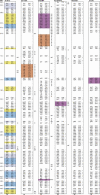Archaeology and evolution of transfer RNA genes in the Escherichia coli genome
- PMID: 16618964
- PMCID: PMC1464854
- DOI: 10.1261/rna.2272306
Archaeology and evolution of transfer RNA genes in the Escherichia coli genome
Abstract
Transfer RNA genes tend to be presented in multiple copies in the genomes of most organisms, from bacteria to eukaryotes. The evolution and genomic structure of tRNA genes has been a somewhat neglected area of molecular evolution. Escherichia coli, the first phylogenetic species for which more than two different strains have been sequenced, provides an invaluable framework to study the evolution of tRNA genes. In this work, a detailed analysis of the tRNA structure of the genomes of Escherichia coli strains K12, CFT073, and O157:H7, Shigella flexneri 2a 301, and Salmonella typhimurium LT2 was carried out. A phylogenetic analysis of these organisms was completed, and an archaeological map depicting the main events in the evolution of tRNA genes was drawn. It is shown that duplications, deletions, and horizontal gene transfers are the main factors driving tRNA evolution in these genomes. On average, 0.64 tRNA insertions/duplications occur every million years (Myr) per genome per lineage, while deletions occur at the slower rate of 0.30 per million years per genome per lineage. This work provides a first genomic glance at the problem of tRNA evolution as a repetitive process, and the relationship of this mechanism to genome evolution and codon usage is discussed.
Figures




Similar articles
-
Genomic divergence of Escherichia coli strains: evidence for horizontal transfer and variation in mutation rates.Int Microbiol. 2005 Dec;8(4):271-8. Int Microbiol. 2005. PMID: 16562379
-
The evolutionary dynamics of tRNA-gene copy number and codon-use in E. coli.BMC Evol Biol. 2015 Aug 19;15:163. doi: 10.1186/s12862-015-0441-y. BMC Evol Biol. 2015. PMID: 26282127 Free PMC article.
-
Codon usage revisited: Lack of correlation between codon usage and the number of tRNA genes in enterobacteria.Biochem Biophys Res Commun. 2018 Aug 25;502(4):450-455. doi: 10.1016/j.bbrc.2018.05.168. Epub 2018 Jun 5. Biochem Biophys Res Commun. 2018. PMID: 29859934 Free PMC article.
-
Codon usage and tRNA content in unicellular and multicellular organisms.Mol Biol Evol. 1985 Jan;2(1):13-34. doi: 10.1093/oxfordjournals.molbev.a040335. Mol Biol Evol. 1985. PMID: 3916708 Review.
-
Origin and Evolution of the Universal Genetic Code.Annu Rev Genet. 2017 Nov 27;51:45-62. doi: 10.1146/annurev-genet-120116-024713. Epub 2017 Aug 30. Annu Rev Genet. 2017. PMID: 28853922 Review.
Cited by
-
Diversity of tRNA genes in eukaryotes.Nucleic Acids Res. 2006;34(21):6137-46. doi: 10.1093/nar/gkl725. Epub 2006 Nov 6. Nucleic Acids Res. 2006. PMID: 17088292 Free PMC article.
-
On distinguishing between canonical tRNA genes and tRNA gene fragments in prokaryotes.RNA Biol. 2023 Jan;20(1):48-58. doi: 10.1080/15476286.2023.2172370. RNA Biol. 2023. PMID: 36727270 Free PMC article.
-
Microevolution of CG23-I Hypervirulent Klebsiella pneumoniae during Recurrent Infections in a Single Patient.Microbiol Spectr. 2022 Oct 26;10(5):e0207722. doi: 10.1128/spectrum.02077-22. Epub 2022 Sep 21. Microbiol Spectr. 2022. PMID: 36129301 Free PMC article.
-
Switches in Genomic GC Content Drive Shifts of Optimal Codons under Sustained Selection on Synonymous Sites.Genome Biol Evol. 2017 Oct 1;9(10):2560-2579. doi: 10.1093/gbe/evw201. Genome Biol Evol. 2017. PMID: 27540085 Free PMC article.
-
The link between independent acquisition of intracellular gamma-endosymbionts and concerted evolution in Tremblaya princeps.Front Microbiol. 2015 Jun 25;6:642. doi: 10.3389/fmicb.2015.00642. eCollection 2015. Front Microbiol. 2015. PMID: 26161080 Free PMC article.
References
-
- Bachellier S., Gilson E., Hofnung M., Hill C.W. Repeated sequences. In: Neidhardt F.C., editor. Escherichia coli and Salmonella: Cellular and molecular biology. ASM Press; Washington, DC: 1996. pp. 2708–2720.
-
- Bennetzen J.L., Hall B.D. Codon selection in yeast. J. Biol. Chem. 1982;257:3026–3031. - PubMed
-
- Blattner F.R., Plunkett G., 3rd, Bloch C.A., Perna N.T., Burland V., Riley M., Collado-Vides J., Glasner J.D., Rode C.K., Mayhew G.F., et al. The complete genome sequence of Escherichia coli K-12. Science. 1997;277:1453–1474. - PubMed
-
- Bulmer M. Coevolution of codon usage and transfer RNA abundance. Nature. 1987;325:728–730. - PubMed
-
- Charlesworth B., Sniegowski P., Stephan W. The evolutionary dynamics of repetitive DNA in eukaryotes. Nature. 1994;371:215–220. - PubMed
Publication types
MeSH terms
Substances
LinkOut - more resources
Full Text Sources
